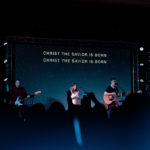
It appears the flow in worship is becoming the end goal, the measuring tool to gauge how successful a worship service was.
By Chris Smith
I was recently discussing worship planning with a fellow worship pastor. I told him I was interested in viewing one of his church’s services. He was flattered and then proceeded to tell me how he and a worship leader friend in another state exchange videos of their services for critique and improvement. As he continued to share, he told me various things they had pointed out to each other, mainly revolving around transitions and the flow of the service.
This conversation bothered my spirit. Although it was encouraging to see fellow worship leaders pushing each other to further excellence, it was discouraging to hear they did not base the criteria on which they judged each other on biblical principles of worship.
Creating idols in our worship gatherings
A quick Google search on flow during worship will provide a number of articles on the topic. Each article is designed to help your church have better “flow” in its services. I’m not opposed to this in any way. We have all seen a service derailed by poor planning. But it appears flow in worship is becoming the end goal, the measuring tool to gauge how successful a worship service was.
The first two of the Ten Commandments God gave were to have no other gods and not make any idols. When we prioritize the flow of a worship service, we are on the path of violating these two commandments.
“Our priority when planning worship services is on allowing the message of Christ to be first and foremost, not on making smooth transitions and avoiding awkward silences.” — Chris Smith Click To TweetBut Colossians 3:16 clearly states the purpose of the gathered body in worship: “Let the message of Christ dwell richly among you, in all wisdom teaching and admonishing one another through psalms, hymns, and spiritual songs, singing to God with gratitude in your hearts” (CSB). Our priority when planning worship services is on allowing the message of Christ to be first and foremost, not on making smooth transitions and avoiding awkward silences. When the main goal of our worship is anything but this, we are creating an idol that takes the place of God’s purpose for our gathering.
Explaining the subtle shift
It appears this shift happened subtly over time. Worship leaders didn’t purposefully set out to make the flow of our services the object of our worship. Some of the reasons are simple. Evaluating the flow of the service is a tangible way to evaluate the gathering. It’s easy to point to what went well or needs work, and there’s usually a prescribed fix for improvement. A second reason is the growing reliance on technology in worship. As worship bands frequently play with support tracks and there are many automated elements of the service, flow is essential to making this work.
But perhaps the main reason we’re more aware of flow is that song transitions have changed in modern worship music. The music minister used to lead three hymns in a row. As the minister directed congregants to stand, the pianist and possibly an organist played the intro. At the conclusion of each hymn, the transition was simple: The music minister said, “Now turn to hymn number X. We’ll sing verses 1, 2, and 4.” While this was happening, the pianist (who already had the next hymn bookmarked) began the intro to the next hymn, and the congregational entrance was obvious.
In current worship music, the song intros are much longer, and frequently have no melodic material. Instruments and pads create beautiful soundscapes, but these often do not tell the congregation when to sing or what song they will be singing. This creates a time of congregational silence (and often uncertainty) that the worship leader must now properly navigate. When we do this well, it can lead to powerful moments of expression. But when it fails, we hear about it during the upcoming staff meeting (or worse, see it on YouTube).
Understanding the negative consequences
There are some negative consequences that have come with this subtle shift. First, it puts undue pressure on those leading worship. Churches may have one or two paid staff in music and worship, but they are working mostly with volunteers. Yet we try to pull off professional-level tasks. Touring worship groups are led by industry experts and have spent months in practice and preparation for these events. Expecting the same quality from the local church is unfair. And when judged to this standard, many worship leaders will become discouraged or depressed. Most worship leaders I know have the correct heart posture but feel a constant pressure for everything to “go right” during services. This slowly shifts the focus of worship to the measurable and practical, instead of the biblical.
“When the focus of the service becomes about everyone on the platform doing the right thing at the right time, worship begins to look more like a performance than a gathering of believers.” — Chris Smith Click To TweetAn overemphasis on flow also teaches the church the wrong things about worship. Worship is about believers speaking the message of Christ to one another. But when the focus of the service becomes about everyone on the platform doing the right thing at the right time, worship begins to look more like a performance than a gathering of believers. We lose the “one another” aspect when many are looking to one or a few. There should certainly still be order, but we must ensure we proclaim the message clearly (1 Corinthians 14:26-40). While I believe order for the sake of clearly communicating the gospel was the original intent behind our collective emphasis on the flow of a service, I fear order has now become a goal unto itself.
Combating the idolatry of flow
Rather than evaluating worship as if it were a production, we need more biblical criteria. In any church gathering, the content of the service should be more important than the methods in which it was delivered. An over-focus on flow shifts this around.
Way before we judge a particular transition or light cue, we need to first ask if the message of Christ was present in all we did. We should certainly strive for musical excellence. But this should not come at the expense of singing to one another in worship as Paul commands in Colossians 3:16 and Ephesians 5:18-19. Before worship leaders are concerned with how they and their team sounded, we should first ask questions like “How well did the people sing?” or “What could we have done to improve the congregation’s participation?”
The Bible is clear on certain features of worship. And we need to ensure man-made aspects of a service do not replace or overshadow the mandated elements such as Scripture reading, prayer, baptism, and communion. If our service is flawless in flow but missing these elements, we may have succeeded in pleasing our fellow man, but not our Savior.
“If our service is flawless in flow but missing biblical elements, we may have succeeded in pleasing our fellow man, but not our Savior.” — Chris Smith Click To TweetAnother suggestion is to monitor our reliance on technology. The recent revivals at Asbury and other college campuses have shown us that the latest and greatest innovations are not a prerequisite for the movement of the Holy Spirit. I am pro-technology, and it’s amazing what you can do using multimedia in a worship service. But these same production elements can often bind us to a rigorous schedule in our worship, or worse, derail a service completely when they malfunction. Technology is a wonderful tool used to assist in delivering the gospel message. But an overreliance on it may create more hindrances in worship than it solves.
Refocusing on worship
A worship service should be well-organized, for Scripture states “God is not a God of disorder but of peace” (CSB). However, much like the Pharisees before us, we often take a principle farther than God intended. In our pursuit for flawless services, are we in danger of losing sight of the God these services are meant to glorify? Let’s refocus our emphasis on flow, making sure it is our servant, not our master.
For permission to republish this article, contact Marissa Postell Sullivan.











